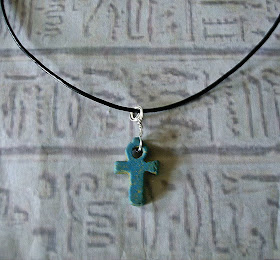Egyptians are well known for their faience beads and Egyptian faience jewellery. Despite it’s appearance it is actually non clay based it is made from sand and crushed quartz and is usually coated in a soda-lime-silica gel. It is still locally produced and imported from Egypt today as it was in ancient Egyptian times.
Probably the most common and popular faience amulet around was probably the scarab and the Ankh The scarab being used in funerary rites and burial chambers to bring good luck. The ankh was a symbol of life and today portrays an Christian cross.
In keeping with ancient Egyptian tradition I have created three new Egyptian faience necklaces using authentic Egyptian faience beads and amulets. A scarab, ankh and the goddess Sekhmet.
Sekhmet was the goddess of healing and is depicted as a lioness. The fiercest hunter known to the Egyptians. It has been said that her breath actually created the desert. She was also known as the protector of the pharoahs.
Today these three amulets are still worn and appreciated in modern culture either as a symbol of good luck or long life and protection. Charms have come and gone over the years but non have stayed with us for so long as some of these ancient Egyptian charms that are still made in Egypt today.
The Ankh and the Sekhmet necklace are both hung on a leather thong while the Scarab amulet is hung on a silver plated curb chain and has crystal lined seed beads added around the perimeter
If modern day jewellery and charms are still a favourite of yours there are still lots of choices to be found in both womens jewellery and men’s jewellery alike.
For any other kind of purchase you may be considering to buy this year then check out Shopseekers for the cheapest prices online including lots of books about making jewellery for yourself if you have a mind to. Remember handmade jewellery comes in lots of shapes and forms and most pieces are unique especially Egyptian faience beads as no two are ever exactly the same.




It's great that you mentioned that the materials on this the Egyptian faience jewellery are sand and crushed quartz otherwise I would really have assumed this was made of clay. These amulets are really lovely by the way.
ReplyDeleteI love the turquoise colours. It is many years since I went to Egypt but was fascinated then about the jewellery and how elaborate it was many 100's of years ago.
ReplyDeleteThanks for sharing Siân :0)